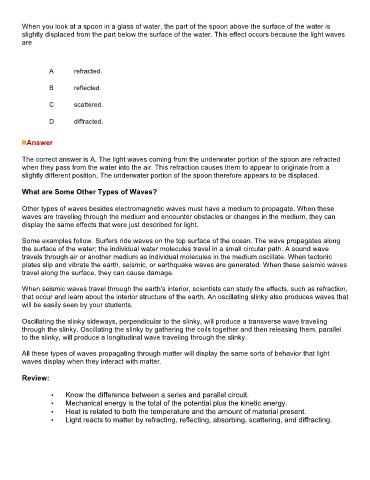Page 355 - ABCTE Study Guide_Neat
P. 355
When you look at a spoon in a glass of water, the part of the spoon above the surface of the water is
slightly displaced from the part below the surface of the water. This effect occurs because the light waves
are
A refracted.
B reflected.
C scattered.
D diffracted.
Answer
The correct answer is A. The light waves coming from the underwater portion of the spoon are refracted
when they pass from the water into the air. This refraction causes them to appear to originate from a
slightly different position. The underwater portion of the spoon therefore appears to be displaced.
What are Some Other Types of Waves?
Other types of waves besides electromagnetic waves must have a medium to propagate. When these
waves are traveling through the medium and encounter obstacles or changes in the medium, they can
display the same effects that were just described for light.
Some examples follow. Surfers ride waves on the top surface of the ocean. The wave propagates along
the surface of the water; the individual water molecules travel in a small circular path. A sound wave
travels through air or another medium as individual molecules in the medium oscillate. When tectonic
plates slip and vibrate the earth, seismic, or earthquake waves are generated. When these seismic waves
travel along the surface, they can cause damage.
When seismic waves travel through the earth's interior, scientists can study the effects, such as refraction,
that occur and learn about the interior structure of the earth. An oscillating slinky also produces waves that
will be easily seen by your students.
Oscillating the slinky sideways, perpendicular to the slinky, will produce a transverse wave traveling
through the slinky. Oscillating the slinky by gathering the coils together and then releasing them, parallel
to the slinky, will produce a longitudinal wave traveling through the slinky.
All these types of waves propagating through matter will display the same sorts of behavior that light
waves display when they interact with matter.
Review:
• Know the difference between a series and parallel circuit.
• Mechanical energy is the total of the potential plus the kinetic energy.
• Heat is related to both the temperature and the amount of material present.
• Light reacts to matter by refracting, reflecting, absorbing, scattering, and diffracting.
! !

